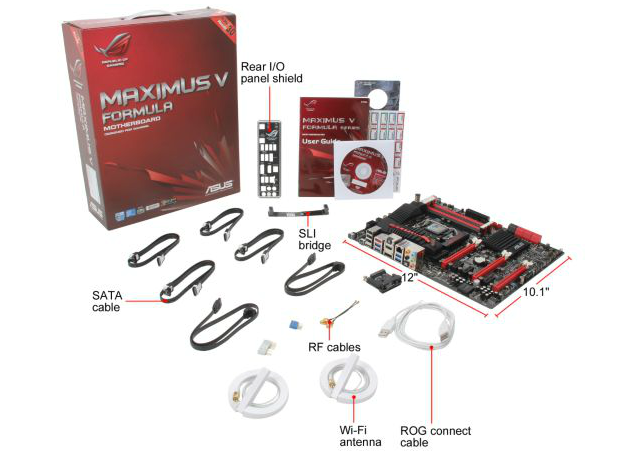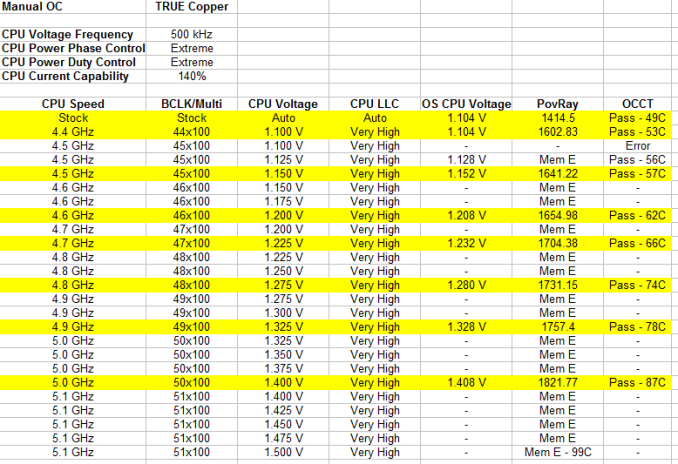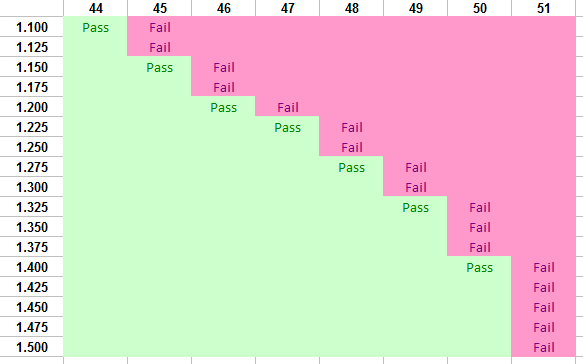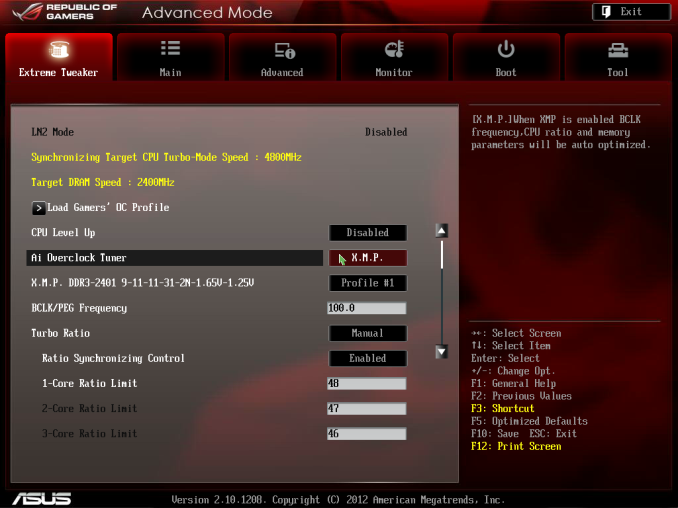ASUS Maximus V Formula Z77 ROG Review
by Ian Cutress on March 25, 2013 2:30 PM EST- Posted in
- Motherboards
- Asus
- ROG
- Z77
ASUS Maximus V Formula In The Box
I am always impressed when a motherboard manufacturer can elbow in a decent set of extra kit in with a SKU. With motherboard margins getting tighter as the total motherboards being sold in 2012 was lower than 2011, it gets harder and harder to find the perfect package. Some golden rules exist – a decent set of SATA cables (at least ½ the number of SATA ports), antenna if WiFi is included, a USB 3.0 panel/bracket if there are at least two USB 3.0 headers on board, and ideally both a rigid SLI and CrossFireX cable if the motherboard is multi-GPU capable. For the high end products, we want something that differentiates the product line, such as a themed USB 3.0 panel, perhaps a gaming related keychain, or motherboard standoffs for overclocking oriented boards.
The ASUS MVF costs a pretty penny for a non-PLX enabled board, despite the wealth of features on board. In terms of in-the-box contents, this translates to:
Rear IO Shield
User Guide
Driver Disk
ROG Door Sign
Cable Labeling Stickers
Six SATA Cables
Flexi-SLI Bridge
WiFi/mSATA Combo Card
RF Cables and Antenna for WiFi
ROG Connect Cable
Q-Connectors for Front Panel

This is a typical ROG Gene/Formula gamut of box contents, and satisfies most of my in-the-box criteria listed above. Aside from the door sign, there is nothing ROG labeled, though using the ROG Connect cable is an obvious sign of an ROG board. I am becoming a big advocate of systems that include plastic standoffs for overclock testing, like the ASRock Z77 OC Formula, so it would be nice to see some here.
ASUS Maximus V Formula Overclocking
Note: Ivy Bridge does not overclock like Sandy Bridge. For a detailed report on the effect of voltage on Ivy Bridge (and thus temperatures and power draw), please read Undervolting and Overclocking on Ivy Bridge.
Experience with ASUS Maximus V Formula
As luck would have it, conditions were perfect for overclock testing on the MVF. Ambient temperatures were low, giving an idle CPU temperature of 15°C on our open test bed and TRUE Copper cooler.
Automatic overclocking options are found both in the OS and BIOS, and for the most part the options (and the results of those options) were the same. While there was not as many options to choose from compared to the ASRock Z77 OC Formula, all the options worked without much of an issue. A couple of points concerned me however – voltages for various clock speeds seemed high (in order to make sure more processors hit the speeds), and no memory OC took place.
Manual overclocking took advantage of our Z77 and i7-3770K overclocking experiences. The MVF accurately applied our selected BIOS voltage at load, and eventually reached 5.0 GHz at 1.400 volts stable under our testing conditions, hitting only 87°C under OCCT load. We tried for 5.1 GHz, although even at 1.500 volts PovRay was not stable and temperatures hit 99°C. The only other motherboard to hit 5.0 GHz stable in our testing was the Z77 MPower, although air testing is always limited by temperatures. This is one area of testing in our reviews we wish to change in the future, to using chilled water.
Methodology:
Our standard overclocking methodology is as follows. We select the automatic overclock options and test for stability with PovRay and OCCT to simulate high-end workloads. These stability tests aim to catch any immediate causes for memory or CPU errors.
For manual overclocks, based on the information gathered from previous testing, starts off at a nominal voltage and CPU multiplier, and the multiplier is increased until the stability tests are failed. The CPU voltage is increased gradually until the stability tests are passed, and the process repeated until the motherboard reduces the multiplier automatically (due to safety protocol) or the CPU temperature reaches a stupidly high level (100ºC+). Our test bed is not in a case, which should push overclocks higher with fresher (cooler) air.
Automatic Overclock:
CPU Level Up software in the OS offers three settings – 4.2 GHz, 4.4 GHz and 4.6 GHz. These options are mirrored in the BIOS with two additional settings – CPU Level Auto and Gamers’ OC.
Results were as follows:
Overall, I personally found the voltages a little high, especially for CPU Level 1+2. The Gamers’ OC option is a great one button tool to get a nice overclock across the board.
Manual Overclock:
For manual overclocking we used the BIOS, starting at our nominal 4.4 GHz and 1.100 volt starting point. Given our previous overclocking experience, the following settings were also changed:
CPU Voltage Frequency: 500 kHz
CPU Power Phase Control: Extreme
CPU Power Duty Control: Extreme
CPU Current Capability: 140%
For every setting we tested stability using a PovRay run and five minutes of OCCT. While not an extensive stability test by any means, it allows us to quickly evaluate every setting on every motherboard in a similar fashion.


Hitting 5.0 GHz at 1.400 volts on our CPU is great. It is a shame we could not get 5.1 GHz, though I am sure under the right water cooling setup it would be possible.
Memory Overclocking
One common thought of ASUS boards is usually memory compatibility and the ability to push certain memory kits. ASUS spend a lot of time ensuring that those purchasing the high end memory kits can use them and push them to their limits (regardless of what real world effect it may have). For our memory testing I take a G.Skill 2x4 GB 2666 11-13-13 1.65 V kit and see where it goes.
Like all Z77 motherboards, the MVF handled XMP gracefully. Moving up a strap to 2800 C11 also provided no issue, being completely stable. What came next surprised me – the system successfully booted at DDR3-2933 C11! At this speed I was near to either the limit of the memory or that of the CPU IMC, having hit DDR3-2950 for overclock competitions. I nudged the BCLK up using TurboV EVO, managing to get DDR3-2962, a new personal record. At this point after a few seconds the system crashed spectacularly, suggesting that perhaps some more voltage or setting tweaks could get the DDR3-2933 stable. The MVF is the best Z77 motherboard we have tested for peak memory speeds so far under our methodology (I do not doubt that a memory enthusiast could do better!).












38 Comments
View All Comments
UzairH - Tuesday, March 26, 2013 - link
When I researched the effects of x8 vs x16, some games did have tangible framerates hits. I also understand there is some latency from the PLX chip, so the question is: does the MVF utilize the PLX when two graphics cards are deployed, or only when 3 are in use?IanCutress - Tuesday, March 26, 2013 - link
The PLX chip on the MVF works with IO as it is a PCIe 2.0 switch. It is not the PLX8747 commonly used to dissect PCIe 3.0 lanes for GPUs.UzairH - Tuesday, March 26, 2013 - link
Thanks for clearing that up Ian :) I take it then that there is NO latency from the PLX chip since it doesn't do anything with the PCIe slots.Overall, I am trying to decide between this board or the ASRock Z77 OC Formula. Ian, which of these two would you use yourself in a gaming build with GTX 670 SLI and a standard overclocked (4.2~4.4 GHz) 3570k? One important value-add is of course the "SupremeFX IV" audio solution on the MVF - I was considering getting one of Asus' Xonar cards for sound, how would you say the SupremeFX IV compares to the DX or Essence STX when paired with good headphones?
hurrakan - Tuesday, March 26, 2013 - link
I wish they would stop using the Intel 82579V NIC, or at least fix it - it's been horrendously broken for years. Search Google for "82579v" and you'll see.It constantly disconnects every minute unless you force it to 100Mbps. I wish I had bought a motherboard with dual LAN. And I'm going to make sure my next motherboard does not have Intel 82579V!
vailr - Tuesday, March 26, 2013 - link
The Intel 82579V NIC has performed fawlessly on my Gigabyte Z77-UD5H board.Maybe your board's NIC has a defect?
hurrakan - Sunday, April 14, 2013 - link
It was fine for a few months, then started disconnecting and reconnecting every 2 minutes - extremely annoying and made playing MMOs impossible. Now it only works by forcing to 100MBps instead of 1GBps.Apparently a very common problem - there's a 13 page thread on Intel community forums.
I saw one place suggest it is caused by the Gigabit Ethernet region of the motherboard BIOS getting corrupted.
Sabresiberian - Tuesday, April 2, 2013 - link
I would rather they add a PLX chip than spend the money on beefing up the audio capabilities of the mainboard. I mean, they did a good job as far as they went, but its still not as good as, say, one of their own Xonar solutions, which is what I'm going to use anyway. To me, either you care about better sound and you are going to spend a little money to get it, or you're happy with what comes on mainboards and so aren't; an in-between solution is a solution for a kind of person that I don't think really exists.Nivin - Thursday, May 2, 2013 - link
Just wondering. Does this motherboard come with a liquid cooling system of its own or is it just optimized for one. I am planning to buy this for my gaming pc but i also am going to buy a Cooler Master Seidon 240m if the motherboard doesnt have its own liquid cooling system. Also, if it does come with a LCS, is it good compared to getting one yourself.Thanks, Nivin